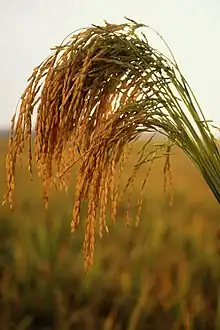Portal:Agriculture/Selected article/4
Rice is the seed of the monocot plants Oryza sativa or Oryza glaberrima. As a cereal grain, it is the most important staple food for a large part of the world's human population, especially in East and South Asia, the Middle East, Latin America, and the West Indies. It is the grain with the second-highest worldwide production, after maize (corn).

Since a large portion of maize crops are grown for purposes other than human consumption, rice is the most important grain with regard to human nutrition and caloric intake, providing more than one fifth of the calories consumed worldwide by the human species.
Rice is normally grown as an annual plant, although in tropical areas it can survive as a perennial and can produce a ratoon crop for up to 30 years. The rice plant can grow to 1–1.8 m (3.3–5.9 ft) tall, occasionally more depending on the variety and soil fertility. It has long, slender leaves 50–100 cm (20–39 in) long and 2–2.5 cm (0.79–0.98 in) broad. The small wind-pollinated flowers are produced in a branched arching to pendulous inflorescence 30–50 cm (12–20 in) long. The edible seed is a grain (caryopsis) 5–12 mm (0.20–0.47 in) long and 2–3 mm (0.079–0.118 in) thick. (Full article...)